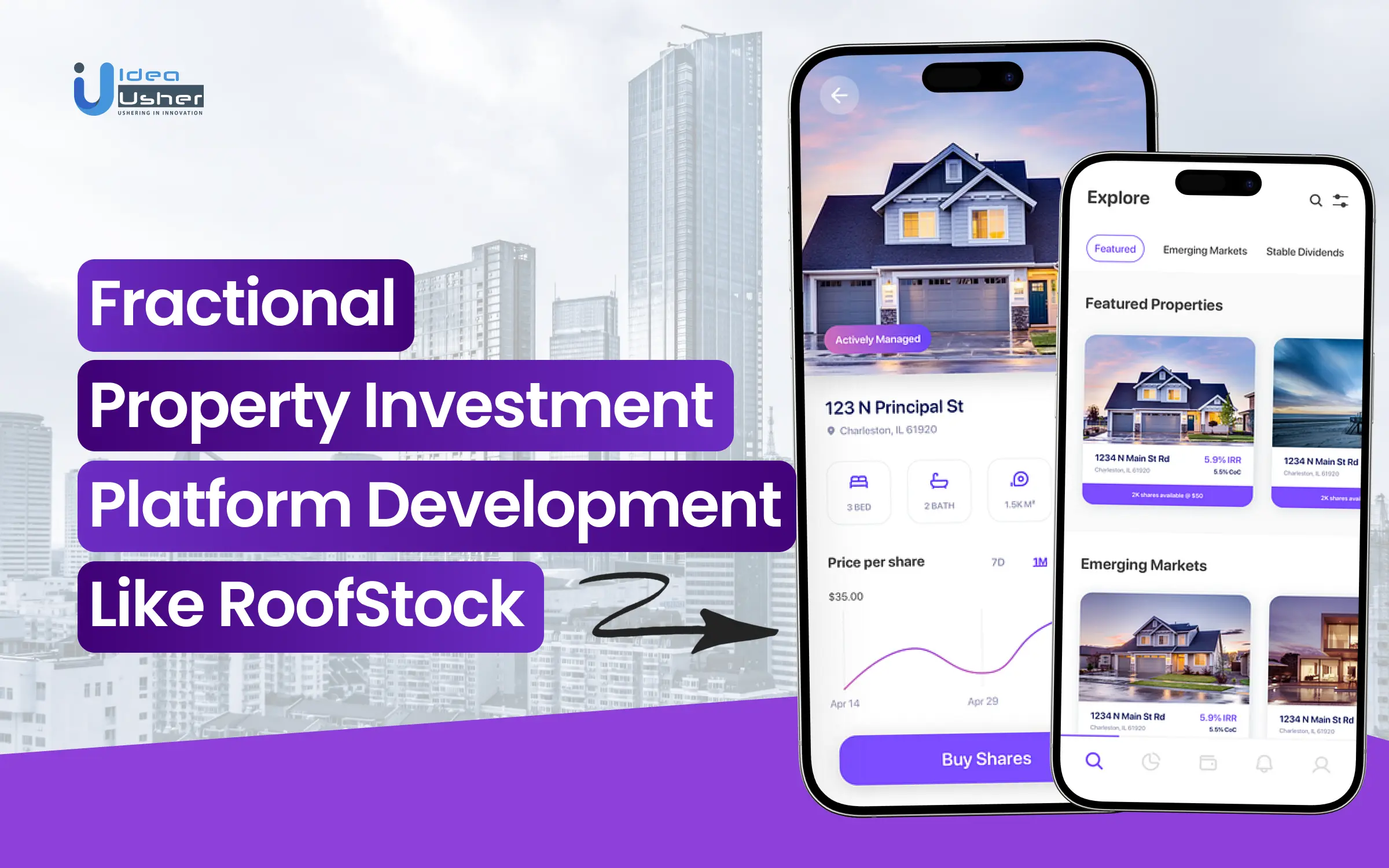Fractional property investment platforms have revolutionized real estate investing, making it easier for individuals to invest in property with as little as a few hundred dollars. Platforms like Roofstock are at the forefront of this trend, offering a marketplace where investors can buy shares in rental properties and earn steady returns, all without the hassle of managing the properties themselves. According to Statista, the global market for fractional ownership is projected to reach $3.1 billion by 2028, reflecting the rising popularity and demand for shared property investments.
Another notable player in this space is CrowdStreet, launched in 2014, which focuses on commercial real estate and allows investors to participate in larger, high-value projects. To date, CrowdStreet has raised over $2 billion across more than 500 deals, with individual investments reaching $641 million in 2020 alone—nearly tripling the amount from 2018.
Building a fractional property investment platform like Roofstock requires careful planning, the right technology, and a deep understanding of real estate and finance. Whether you’re an entrepreneur entering the market or a developer building the platform, this blog will walk you through the essential elements needed to create a successful and scalable fractional property investment platform.
Overview of the Roofstock Platform
Roofstock is an online platform designed to simplify investing in SFR properties. Catering to both accredited and non-accredited investors, the platform enables users to buy and sell tenant-occupied homes across the United States. Since its launch, Roofstock has experienced rapid growth, surpassing $2 billion in transaction volume within just three years, establishing its strong presence in the real estate market.
Key Features
- Support for International Investors: Roofstock allows international investors to participate in U.S. rental property investments without needing to be physically present.
- Flexible Investment Options: Users can choose to invest in individual properties or entire portfolios, offering flexibility in crafting personalized investment strategies.
- No Minimum Investment (Standard Platform): The standard platform has no minimum deposit requirement, making it accessible to a wide range of investors. However, for Roofstock One, a minimum investment of $5,000 is needed, allowing accredited investors to purchase shares in individual properties.
How Does the Roofstock Platform Use AI?
Roofstock leverages AI in several ways to make real estate investing easier, smarter, and more efficient for investors. Here’s how they use AI on their platform:
1. Smarter Property Valuation
Roofstock works with HouseCanary’s AI-powered analytics to provide better property appraisals. By analyzing real-time data about neighborhoods and trends, AI helps the team assess property values more accurately than traditional methods. This speeds up the process, so Roofstock can handle more properties without losing quality.
2. Finding the Best Investment Opportunities
AI plays a key role in identifying promising investment opportunities. By processing large amounts of data, including rental trends and market conditions, Roofstock helps investors make more informed decisions on where to buy, how to manage, and what strategies to apply.
3. Automating Property Management
AI also makes managing properties more efficient. Through AI-powered chatbots, Roofstock can handle tenant inquiries, schedule maintenance, and process rent payments. This not only improves tenant satisfaction but also saves property managers time, making operations run smoothly.
4. Improved Tenant Screening
Using AI, Roofstock enhances the tenant screening process, ensuring that only reliable and qualified tenants are selected for properties. This minimizes risks like evictions and helps property owners maintain steady rental income.
5. Data-Driven Decisions
Roofstock uses data to match investment opportunities with investors’ goals and risk profiles. Their in-house team uses historical data to make decisions faster and more accurately, speeding up transactions and improving the overall investment experience.
Key Market Takeaways for Fractional Property Investment Platform
Source: CustomMarketInsights
This growth is driven by two key factors: affordability and technological advancements, which make real estate investment accessible to more people, even without large upfront capital.
In the U.S., platforms like Roofstock, based in Oakland, are leading the charge. They allow individuals to invest in either full or fractional shares of rental properties, making it easier for people to enter the real estate market. Another notable platform, CrowdStreet, has raised over $2 billion since its launch in 2014. It offers access to top-tier commercial real estate projects with a minimum investment of just $25,000.
Moreover, some states, like California and New York, are introducing new regulations to improve consumer protection in real estate transactions. These changes are having an impact on how fractional ownership platforms operate, ensuring safer investments for everyone involved.
Work with Ex-MAANG developers to build next-gen apps schedule your consultation now
A Great Time to Invest in Property Investment Platform Development
Starting a fractional property investment platform like Roofstock is a great opportunity, especially as more people are looking for ways to invest in real estate without needing huge sums of money upfront. For example, platforms like GroundFloor allow people to start investing with as little as $10, focusing on short-term projects. This has proven to be a hit, raising over $4 million from around 2,000 investors!
It’s clear that investors are eager to get involved in real estate, even with smaller contributions, making this an ideal time for developers to tap into this growing market.
The potential for profits is strong because of the recurring fees these platforms generate, such as transaction fees and property management commissions. Take BRXS, for instance, which lets people invest in real estate notes starting at €100. With various fee structures based on the deal and property value, platforms can scale quickly and adjust to different market needs. This makes the business model both flexible and profitable, appealing to investors who want access to real estate without the hassle of traditional ownership.
What makes this model even more exciting is its scalability. As these platforms grow, they can expand into different cities or types of properties, attracting a wider pool of investors. Plus, with technology making property management easier, operational costs can be minimized.
Did you know that….
Stake, a Dubai-based fractional property investment platform, just raised $14 million to expand into Saudi Arabia and Abu Dhabi. With real estate booming in the UAE, especially in Dubai, where rents jumped 23% in 2024, Stake is capitalizing on the growing demand. The funding round was led by Middle East Venture Partners, with notable participation from Mubadala Investment Company and Aramco’s Wa’ed Ventures. Founded in 2020, Stake aims to offer more diverse investment opportunities, including in commercial real estate, and is making waves in the region’s property market!
Platforms like these show that fractional property investment is not just a trend but a solid, growing industry, offering plenty of opportunities for both businesses and investors alike!
Business Model of the Roofstock Platform
Roofstock is an innovative online marketplace that makes buying and selling leased single-family rental homes easier for both individual and institutional investors. Founded in 2015 and based in Oakland, California, Roofstock uses technology and data analytics to provide a transparent and efficient platform for investors to evaluate, purchase, and manage residential rental properties.
Business Model
Roofstock operates on a marketplace business model, connecting buyers and sellers of single-family rental properties. The platform offers several services to make the process smoother for investors:
- Property Analysis and Certification: Roofstock pre-certifies properties by inspecting them and providing detailed reports about tenants, current rent, and property management. This helps build trust with investors.
- Transaction Facilitation: Investors can buy or invest in validated listings without needing to inspect properties in person, streamlining the process.
- Roofstock One: This unique service enables fractional ownership of rental homes. Instead of purchasing an entire property, investors can buy shares, with property management included to further ease the investment process.
Revenue Streams
Roofstock generates income through several channels:
- Transaction Fees: Sellers pay a fee of 2.5% of the sale price (with a minimum of $500), while buyers pay 0.5% of the contract price (or a minimum of $500, whichever is higher).
- Property Management Fees: Roofstock charges a fee based on a percentage of monthly rental income for managing properties purchased through its platform.
- Listing Fees: Property owners pay a fee to list their homes on the Roofstock marketplace.
- Financing Fees: Roofstock also earns revenue from providing financing options to investors.
Financial Performance
By early 2020, Roofstock had facilitated over $2 billion in transactions across 24 states. As of early 2024, total transactions surpassed $6 billion, showcasing the platform’s rapid growth and popularity among both retail and institutional investors seeking opportunities in the single-family rental market.
Funding History
Roofstock has raised a total of $125 million across multiple funding rounds to fuel its growth:
- Series A (2016): $13.3 million from investors like Khosla Ventures and Marc Benioff.
- Series B (2016): $20 million.
- Series C (2017): $50 million, led by Canvas Ventures.
- Series D (2020): $50 million at a valuation of $428 million, with participation from Khosla Ventures and Lightspeed Venture Partners.
These funding rounds have helped Roofstock expand its services and technology, solidifying its position as a leader in the real estate investment space.
Development Steps for a Fractional Property Investment Platform like Roofstock
Here are the important steps to develop a fractional property investment platform like Roofstock,
Step 1: Define the Business Model and Goals
Identify the platform’s core offerings, such as single-family rental properties or commercial real estate. Establish whether the platform will focus on fractional ownership, full property investment, or both. Define the target audience, including individual investors and institutional clients.
Step 2: Conduct Market Research
Analyze competitors, market trends, and investment patterns to identify gaps and opportunities. Study user expectations regarding features like property certification, analytics, and management tools.
Step 3: Develop a User-Friendly Platform
Create a web and mobile platform with intuitive navigation. Focus on features like advanced property search filters, seamless transaction processes, and interactive dashboards for financial projections.
Step 4: Integrate Property Listings and Certification Tools
Build a backend system to manage property data. Implement a certification process that ensures listed properties meet specific investment criteria, including inspection reports, financial stability, and tenant status.
Step 5: Offer Advanced Data Analytics
Provide users with detailed insights, such as neighborhood ratings, projected rental yields, and cash flow analysis. Utilize AI-powered algorithms for personalized investment recommendations.
Step 6: Streamline the Investment Process
Incorporate tools for investors to make direct offers, negotiate, and finalize transactions securely online. Include a digital wallet or escrow system to manage funds efficiently.
Step 7: Establish Property Management Services
Partner with reliable property management companies to handle daily operations like tenant communication, rent collection, and maintenance. Integrate these services within the platform for user convenience.
Step 8: Ensure Regulatory Compliance and Security
Adhere to property investment regulations, including tax compliance and licensing. Implement robust security features like data encryption, secure payment gateways, and multi-factor authentication to protect user data.
Step 9: Launch and Continuously Improve
Start with a soft launch, gathering feedback from early users to refine features and address issues. Continuously update the platform by integrating new technologies, expanding property listings, and improving user experience.
Cost of Developing a Fractional Property Investment Platform like Roofstock
| Development Stage | Description | Estimated Cost Range |
| 1. Research & Market Analysis | – Competitive analysis of similar platforms.- Market research on investor demographics and preferences.- Feasibility studies and business plan. | $2,000 – $8,000 |
| 2. Platform Development | Frontend Development:– UI/UX Design: Create an intuitive, responsive interface for web.- Development: Build using modern frameworks like React or Angular. Backend Development:– Basic property listing and management.- Ownership tracking system for fractional shares.- Payment gateway integration for secure transactions.- Investor dashboard with basic reporting.- Security measures to ensure compliance. | $5,000 – $50,000 |
| 3. App Development (Optional) | – Simple mobile app for property browsing and portfolio tracking.- Notifications for updates.- Secure messaging for investor communication. | $3,000 – $15,000 |
| 4. Legal & Regulatory Compliance | – Entity formation and registration.- Drafting agreements for investors and property owners.- Ensuring basic compliance with securities laws. | $2,000 – $10,000 |
| 5. Marketing & Sales | – Content marketing and SEO for visibility.- Social media promotions.- Investor outreach through online campaigns. | $2,000 – $10,000 |
| 6. Testing & Quality Assurance | – Functionality testing of platform components.- User acceptance testing to gather feedback.- Bug fixing and performance improvements. | $1,000 – $5,000 |
| 7. Ongoing Maintenance & Support | – Hosting, platform updates, and customer support.- Security monitoring to address potential vulnerabilities. | $1,000 – $5,000/month |
Total Estimated Cost: $10,000 – $100,000
Factors Affecting the Development Cost of a Fractional Property Investment Platform like Roofstock
Several factors can significantly impact the development cost of a fractional property investment platform. Here are some key variables:
- Fractionalization Engine: Developing a robust system for dividing property ownership, tracking fractional shares, and managing complex financial transactions requires specialized expertise and can increase development costs.
- Property Due Diligence and Risk Assessment: Integrating tools and processes for thorough property due diligence, risk assessment, and ongoing monitoring of property performance adds complexity and cost.
- Regulatory Compliance Specific to Fractional Ownership: Meeting specific regulatory requirements related to fractional ownership, such as securities laws and investor protection regulations, can increase legal and compliance costs.
- Investor Education and Onboarding: Providing comprehensive investor education materials and a smooth onboarding process for new investors can require significant resources.
Conclusion
Fractional property investment platforms like Roofstock are making real estate investing more accessible to people who may not have had the capital to get involved before. By allowing investors to own a fraction of a property, these platforms offer the benefits of diversification, better liquidity, and the potential for higher returns compared to traditional real estate investments. Businesses can tap into this trend by creating similar platforms, earning revenue through platform fees, asset management charges, and possibly by participating in investment deals.
Looking to Develop a Fractional Property Investment Platform like Roofstock?
With over 500,000 hours of coding experience, Idea Usher is here to help you build a powerful and easy-to-use platform that makes real estate investing accessible to everyone. We specialize in creating innovative solutions that use technology to connect investors with great opportunities. Ready to bring your vision to life? Get in touch with us today for a free consultation!
Work with Ex-MAANG developers to build next-gen apps schedule your consultation now
FAQs
Q1: How to develop a property investment platform?
A1: Developing a property investment platform starts with understanding your target audience, whether it’s individuals looking to invest in residential or commercial properties or larger institutional investors. You’ll need to design a user-friendly website or app that enables seamless browsing of property listings, secure transactions, and portfolio tracking. The platform should include robust payment integrations, secure registration, and legal document management. It’s also important to ensure the platform meets all regulatory compliance requirements.
Q2: What is the cost of developing a property investment platform?
A2: The cost of developing a property investment platform varies depending on the platform’s complexity, features, and the development team you hire. A basic platform with essential features like property listings and payment systems will typically cost less than a more advanced platform with custom functionalities, advanced analytics, and regulatory compliance features. Other factors like design, user experience, and the integration of third-party services (like legal or payment systems) also influence the price.
Q3: What are the features of a property investment platform?
A3: A property investment platform typically includes features like detailed property listings with financial metrics (such as potential returns), secure user registration and login, and a payment system for transactions. It should allow investors to view and track their portfolios, manage deposits, and make withdrawals. Other important features include document management (for contracts and legal agreements), notifications about new investment opportunities, a dashboard for monitoring investment performance, and customer support.
Q4: How do fractional property investment platforms make money?
A4: Fractional property investment platforms make money by charging various fees. These may include management fees, which are typically a percentage of the funds raised or the assets managed, as well as transaction fees for buying or selling shares in properties. Platforms often earn a success fee based on the returns generated from investments. Some platforms charge investors a fee when they buy or sell fractional shares in properties, while others may charge property owners or developers a fee to list their properties on the platform.






















